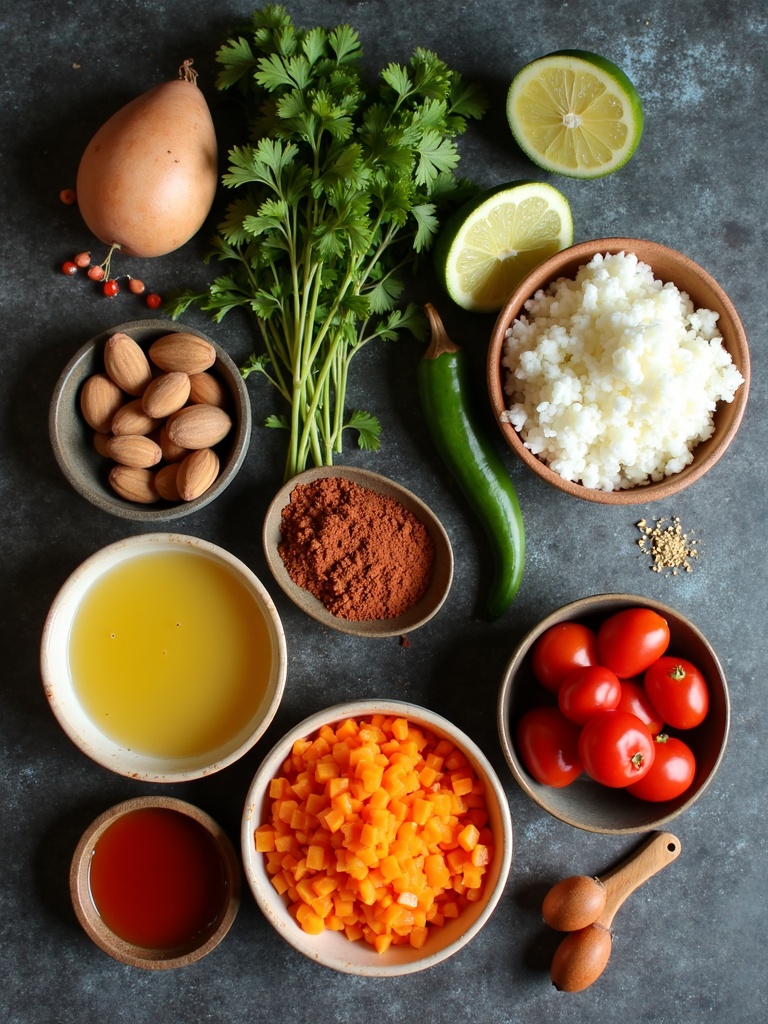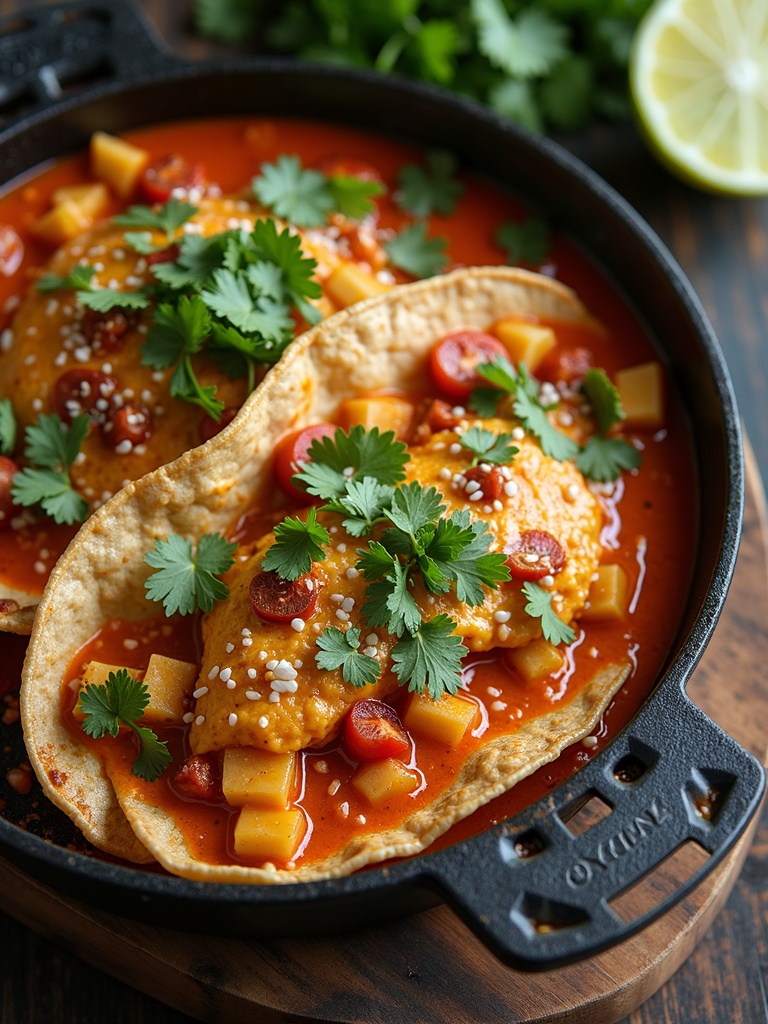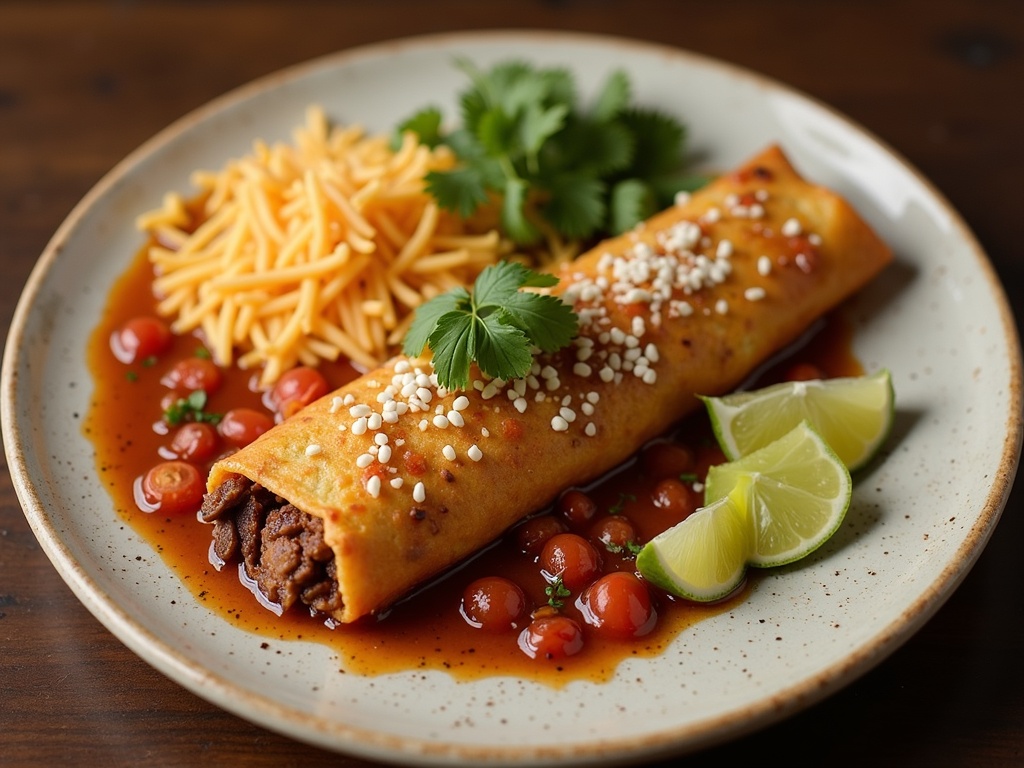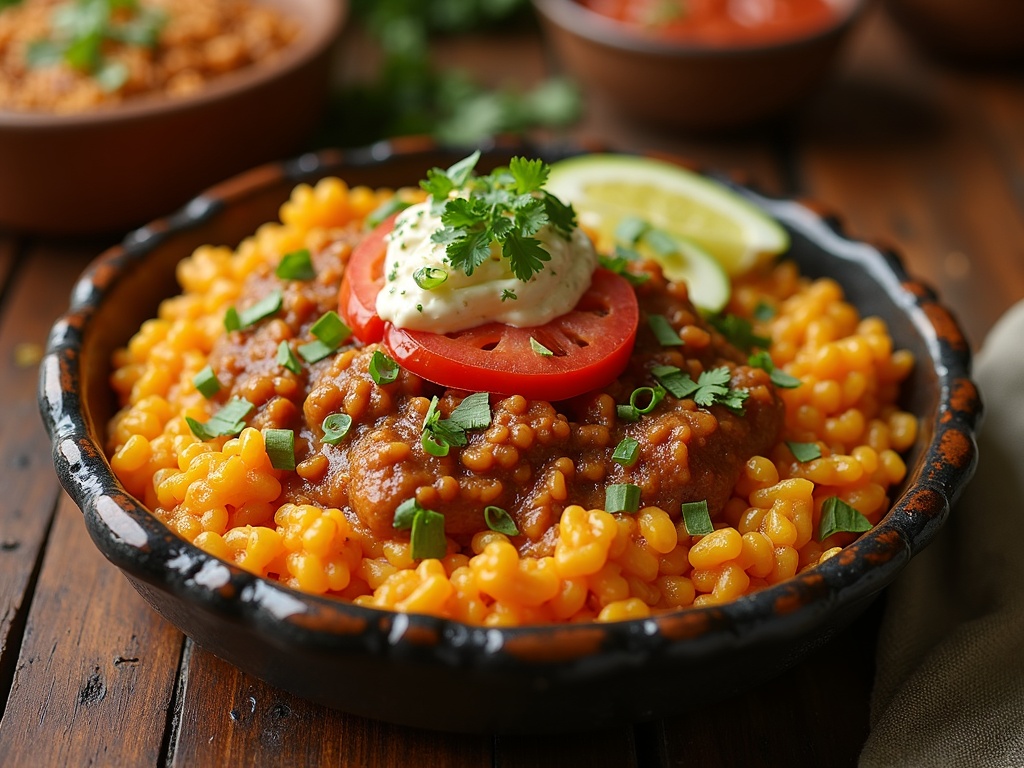Introduction
Mexican cuisine is a vibrant tapestry of flavors, colors, and traditions that has captivated food lovers worldwide. From the smoky depths of mole poblano to the fresh zing of street tacos, Mexican dishes offer an incredible diversity that reflects the country’s rich cultural heritage.
Table of Contents
Ingredients You Will Need

To create authentic Mexican dishes, you’ll need a well-stocked pantry with these essential ingredients:
- Corn tortillas: The foundation of many Mexican dishes, providing a distinctive earthy flavor that flour tortillas can’t match
- Dried chiles: Ancho, guajillo, and chipotle peppers add depth, smokiness, and varying heat levels
- Fresh chiles: Jalapeños, serranos, and poblanos for bright, vibrant heat and flavor
- Tomatoes: Both fresh and canned are used extensively in salsas, sauces, and stews
- Tomatillos: These tangy, green fruits are essential for authentic green salsas and enchilada sauces
- Onions and garlic: The aromatic base for virtually all Mexican dishes
- Cilantro: This fresh herb adds a distinctive brightness to many dishes
- Lime: The acidic punch that balances rich flavors in salsas, guacamole, and as a finishing squeeze
- Cumin, oregano, and cinnamon: Key spices that define the flavor profiles of many dishes
- Beans: Black beans and pinto beans are staples, used whole or refried
- Rice: Often prepared with tomato and spices for an aromatic side dish
- Avocados: For creamy, rich guacamole and as a topping
- Queso fresco, Cotija, and Oaxaca cheese: Traditional Mexican cheeses that add creaminess and salt
- Masa harina: Corn flour treated with lime, used for making tortillas, tamales, and thickening soups
For the freshest pico de gallo recipe, you’ll need ripe tomatoes, red onion, jalapeño, cilantro, lime juice, and salt.
Timing
Creating authentic Mexican dishes requires varying preparation and cooking times depending on the recipe:
- Quick dishes (30 minutes or less): Street tacos, quesadillas, and simple salsas
- Medium preparation (30-60 minutes): Enchiladas, chiles rellenos, and Mexican rice
- Slow-cooked specialties (1-4+ hours): Mole sauces, authentic carnitas, and pozole stew
- Advance preparation dishes: Tamales and certain marinades benefit from overnight resting
Traditional methods like nixtamalization (preparing corn with lime) for tortillas can take up to 24 hours, though modern shortcuts have reduced this significantly. Most home cooks can prepare a complete Mexican meal with multiple dishes in about 1.5-2 hours, which is comparable to other global cuisines with complex flavor profiles.
Step-by-Step Instructions

Step 1: Master the Basics
Begin your Mexican cooking journey by learning to make authentic corn tortillas from masa harina and water. Press the dough between wax paper using a tortilla press or a heavy pan, then cook for 30-45 seconds per side on a hot comal or cast-iron skillet until they puff slightly. Fresh homemade tortillas will elevate any dish they’re used in.
Step 2: Create Versatile Salsas
Develop your salsa-making skills by preparing both cooked and fresh versions. For a roasted salsa, char tomatoes, jalapeños, and garlic under a broiler until blackened in spots. Blend with fresh cilantro, lime juice, and salt for a smoky background flavor. For fresh options, try making a vibrant pico de gallo by finely dicing tomatoes, onions, and jalapeños, then mixing with cilantro, lime juice, and salt.
Step 3: Perfect Mexican Rice
Start by sautéing 2 cups of long-grain rice in oil until lightly golden. Add 4 cups of chicken broth, a cup of pureed tomatoes, minced garlic, diced onion, and spices (cumin, oregano). Bring to a boil, reduce heat, cover, and simmer for 20 minutes until the liquid is absorbed. Let stand covered for 10 minutes, then fluff with a fork for the perfect side dish.
Step 4: Master Authentic Tacos
Heat corn tortillas on a hot skillet until soft and pliable. For traditional tacos al pastor, marinate thinly sliced pork in a mixture of dried chiles, achiote paste, pineapple juice, and spices. Cook on high heat until slightly crisp. Serve on tortillas with diced onion, cilantro, pineapple, and a squeeze of lime. Remember that authentic Mexican tacos are usually served on small corn tortillas with minimal toppings to let the meat shine.
Step 5: Explore Regional Specialties
Move beyond the basics to regional specialties like Yucatecan cochinita pibil (slow-cooked pork in achiote and citrus) or Oaxacan black mole. For a simplified black mole, toast and blend dried chiles, nuts, seeds, chocolate, and spices into a complex paste, then simmer with broth until thickened. These dishes showcase the incredible diversity within Mexican cuisine.
Step 6: Perfect Complementary Sides
Complete your meal with traditional Mexican vegetable side dishes, such as calabacitas (sautéed zucchini with corn and cheese), nopales (cactus paddles), or charro beans. These sides add freshness, texture, and nutritional balance to heartier main dishes.
Step 7: Master Mexican Sauces
Learn to make essential sauces like enchilada sauce, mole, or chipotle sauce. For a simple enchilada sauce, toast dried guajillo chiles, then simmer with garlic, onion, and tomatoes before blending and straining. A good sauce forms the foundation of many authentic dishes.

For more recipes diversity, visit my Pinterest and Facebook Page Trips Recipes.
Nutritional Information
Mexican dishes can be nutritionally balanced when prepared with traditional ingredients and methods:
- Many traditional recipes feature nutrient-dense ingredients like beans, fresh vegetables, and herbs
- Corn tortillas are naturally gluten-free and contain less fat than flour tortillas
- Bean-based dishes provide plant protein and fiber, with approximately 7-8g protein per ½ cup serving
- Fresh salsas are low in calories (approximately 20-30 calories per ¼ cup) and rich in vitamins
- Avocados contain heart-healthy monounsaturated fats and approximately 10g of fat per serving
- Authentic Mexican cuisine uses less cheese than Americanized versions, reducing saturated fat content
- Traditional cooking methods often use less oil than typical Western cooking techniques
- Typical restaurant portions of rice and beans contain approximately 200-300 calories combined
- Chiles contain capsaicin, which may boost metabolism and has anti-inflammatory properties
- Cilantro and lime add flavor with minimal calories while providing vitamin C and antioxidants
Healthier Alternatives for the Recipe
Make your Mexican dishes even more nutritious with these smart modifications:
- Replace fried tortillas with baked ones to reduce oil content by approximately 50-70%
- Use Greek yogurt instead of sour cream to boost protein while cutting fat content in half
- Opt for lean proteins like chicken breast, fish, or extra lean ground beef (93% lean)
- Increase the vegetable-to-meat ratio in fillings for tacos, burritos, and enchiladas
- Try cauliflower rice as a lower-carb alternative to traditional Mexican rice
- Make bean-based dishes the star rather than meat-heavy options
- Reduce cheese quantities and opt for stronger flavored varieties like cotija so a little goes further
- Use whole grain corn tortillas for additional fiber and nutrients
- Control sodium by making sauces and seasonings from scratch rather than using packaged versions
- Replace lard with heart-healthy oils like olive or avocado oil when possible
- Add extra vegetables to traditional recipes for increased nutritional value
Serving Suggestions
Elevate your Mexican dishes with these appealing serving ideas:
- Create a DIY taco bar with warm tortillas and various fillings for interactive family dining
- Serve a trio of colorful salsas (red, green, and pico de gallo) in small bowls for visual appeal
- Garnish plates with fresh cilantro sprigs, radish slices, and lime wedges for a restaurant-quality presentation
- Accompany spicy dishes with cooling elements like avocado slices or Mexican crema
- Provide small dishes of traditional condiments like pickled onions, jalapeños, and chopped onions
- Serve rice and beans in separate colorful vessels for contrasting colors and textures
- Enhance presentation with edible flowers like squash blossoms for special occasions
- Offer warm tortillas wrapped in a cloth napkin within a tortilla warmer or basket
- Accompany meals with aguas frescas (fruit waters) in colorful pitchers for an authentic touch
- Consider serving family-style with large platters at the center of the table to encourage sharing
- Garnish rim of serving bowls with lime wheels for soups like pozole or menudo
Common Mistakes to Avoid
Sidestep these pitfalls when preparing authentic Mexican dishes:
- Using flour tortillas for dishes that traditionally call for corn tortillas (like street tacos or enchiladas)
- Drowning tacos in toppings—authentic Mexican tacos are simply dressed with onions, cilantro, and perhaps a squeeze of lime
- Overcooking rice until it becomes mushy instead of achieving separate, fluffy grains
- Using pre-shredded cheese, which contains anti-caking agents that prevent proper melting
- Adding cumin to everything—it’s important in some dishes but isn’t universal to all Mexican cooking
- Confusing Tex-Mex and authentic Mexican cuisines, which have distinct flavor profiles and ingredients
- Neglecting to toast dried chiles before using them, missing out on their complex flavor development
- Using bottled lime juice instead of fresh—the bright acidity is crucial for authentic flavor
- Rushing slow-cooked dishes like carnitas or mole, which need time to develop their flavors
- Skipping the critical step of properly salting each component of a dish
- Assuming all Mexican food is spicy—many traditional dishes showcase complex, mild flavors
Storing Tips for the Recipe
Keep your Mexican dishes fresh and flavorful with these storage recommendations:
- Store homemade tortillas at room temperature in a sealed plastic bag for 2-3 days, or refrigerate for up to a week
- Freeze prepared fillings like carnitas or tinga in portion-sized containers for quick weeknight meals
- Keep salsas in airtight glass containers in the refrigerator for 5-7 days, though fresh pico de gallo is best consumed within 1-2 days
- Store leftover guacamole with plastic wrap pressed directly onto the surface to prevent browning
- Refrigerate cooked rice and beans in separate containers for 3-4 days, adding a splash of water when reheating
- Freeze dried chiles in sealed bags for up to 6 months to maintain freshness and flavor
- Store masa harina and corn flour in airtight containers in a cool, dry place for up to 6 months
- Freeze homemade tamales individually wrapped in plastic, then stored in freezer bags for up to 3 months
- Keep fresh herbs like cilantro with stems in a glass of water in the refrigerator, covered loosely with a plastic bag
- Refrigerate leftover mole sauce for up to a week, or freeze in ice cube trays for portion-controlled use
- Allow complex dishes like pozole or menudo to rest overnight in the refrigerator for improved flavor the next day
Conclusion
The world of Mexican dishes offers an incredible journey through flavors, techniques, and traditions that have evolved over centuries. From the simple perfection of a street taco to the complex depths of a mole sauce, these recipes tell the story of Mexico’s diverse culinary heritage. By mastering a few fundamental techniques and understanding the authentic ingredients, you can create restaurant-quality Mexican dishes that will transport your taste buds south of the border.
FAQs
What are the most popular authentic Mexican dishes?
Some of the most popular authentic Mexican dishes include tacos al pastor (marinated pork tacos), chiles rellenos (stuffed peppers), mole poblano (complex sauce with chocolate and chiles), pozole (hominy stew), cochinita pibil (slow-roasted pork), and enchiladas with various regional preparations. These dishes showcase the incredible diversity of Mexican regional cuisines.
How is authentic Mexican food different from Tex-Mex?
Authentic Mexican dishes typically use corn tortillas rather than flour, feature less cheese, incorporate a wider variety of chiles, and include regional specialties like moles and ceviches. Tex-Mex, which developed in Texas, often features flour tortillas, yellow cheese, cumin-heavy seasonings, and Americanized dishes like nachos and fajitas that aren’t traditional to Mexico.
What are essential ingredients for authentic Mexican cooking?
Essential ingredients include corn tortillas, dried and fresh chiles, tomatillos, cilantro, lime, Mexican oregano, beans, rice, and traditional Mexican cheeses like cotija and queso fresco. Having access to masa harina (nixtamalized corn flour) is also important for making authentic tortillas and tamales.
Is Mexican food always spicy?
No, not all Mexican dishes are spicy. While chiles are fundamental to the cuisine, they’re often used for flavor complexity rather than just heat. Many traditional dishes like arroz con leche (rice pudding), chiles rellenos, and certain moles have mild, complex flavors without significant spiciness. Mexican cuisine offers a wide range of heat levels to suit different preferences.
What are some vegetarian Mexican dishes?
Mexico offers numerous delicious vegetarian options including chile rellenos (cheese-stuffed poblano peppers), enfrijoladas (tortillas in bean sauce), vegetable quesadillas, nopalitos (cactus salad), vegetarian sopes and tlacoyos (thick masa cakes with toppings), and calabacitas con queso (zucchini with corn and cheese). These dishes showcase the versatility of Mexican dishes beyond meat-based options.
How can I make restaurant-quality Mexican rice?
For restaurant-quality Mexican rice, toast the rice in oil until lightly golden before adding liquid. Use chicken broth and tomato puree for the cooking liquid, along with sautéed onion, garlic, and spices. Cook covered until all liquid is absorbed, then let it rest untouched for 10 minutes before fluffing with a fork. This resting period is crucial for perfectly separated grains.

Mexican Dishes
- Total Time: PT2H
- Yield: 4 servings
Description
A comprehensive guide to authentic Mexican cuisine featuring traditional recipes, techniques, and cultural insights.
Ingredients
- Corn tortillas: The foundation of many Mexican dishes, providing a distinctive earthy flavor that flour tortillas can’t match
- Dried chiles: Ancho, guajillo, and chipotle peppers add depth, smokiness, and varying heat levels
- Fresh chiles: Jalapeños, serranos, and poblanos for bright, vibrant heat and flavor
- Tomatoes: Both fresh and canned are used extensively in salsas, sauces, and stews
- Tomatillos: These tangy, green fruits are essential for authentic green salsas and enchilada sauces
- Onions and garlic: The aromatic base for virtually all Mexican dishes
- Cilantro: This fresh herb adds a distinctive brightness to many dishes
- Lime: The acidic punch that balances rich flavors in salsas, guacamole, and as a finishing squeeze
- Cumin, oregano, and cinnamon: Key spices that define the flavor profiles of many dishes
- Beans: Black beans and pinto beans are staples, used whole or refried
- Rice: Often prepared with tomato and spices for an aromatic side dish
- Avocados: For creamy, rich guacamole and as a topping
- Queso fresco, Cotija, and Oaxaca cheese: Traditional Mexican cheeses that add creaminess and salt
- Masa harina: Corn flour treated with lime, used for making tortillas, tamales, and thickening soups
Instructions
1. Make fresh corn tortillas by mixing masa harina with water, pressing the dough between wax paper, and cooking each side for 30–45 seconds on a hot skillet until puffed and cooked through.
2. Prepare both roasted and fresh salsas. For a smoky salsa, char tomatoes, jalapeños, and garlic, then blend with cilantro, lime, and salt. For a fresh version, make pico de gallo with diced tomatoes, onions, jalapeños, cilantro, lime juice, and salt.
3. Sauté long-grain rice in oil until golden, then add chicken broth, pureed tomatoes, garlic, onion, cumin, and oregano. Simmer covered for 20 minutes, then let it rest and fluff for flavorful, fluffy Mexican rice.
4. Warm tortillas and fill with marinated meats like pork al pastor, cooked until crisp. Top simply with diced onion, cilantro, pineapple, and lime to let the meat shine, as in authentic tacos.
5. Try regional dishes like cochinita pibil or black mole. Make simplified mole by blending toasted dried chiles, nuts, seeds, chocolate, and spices, then simmering with broth into a rich sauce.
6. Serve sides like calabacitas (zucchini with corn and cheese), nopales (cactus), or charro beans. These traditional vegetables complement main dishes with added flavor and nutrition.
7. Create essential sauces such as enchilada or chipotle sauce by toasting and simmering dried chiles with garlic, onion, and tomatoes. Blend and strain for a smooth, flavorful base.
Notes
Master the techniques and flavors of genuine Mexican cooking with these traditional dishes.
- Prep Time: PT30M
- Cook Time: PT30M
- Category: Main Course
- Method: Stovetop, Baking
- Cuisine: Mexican

